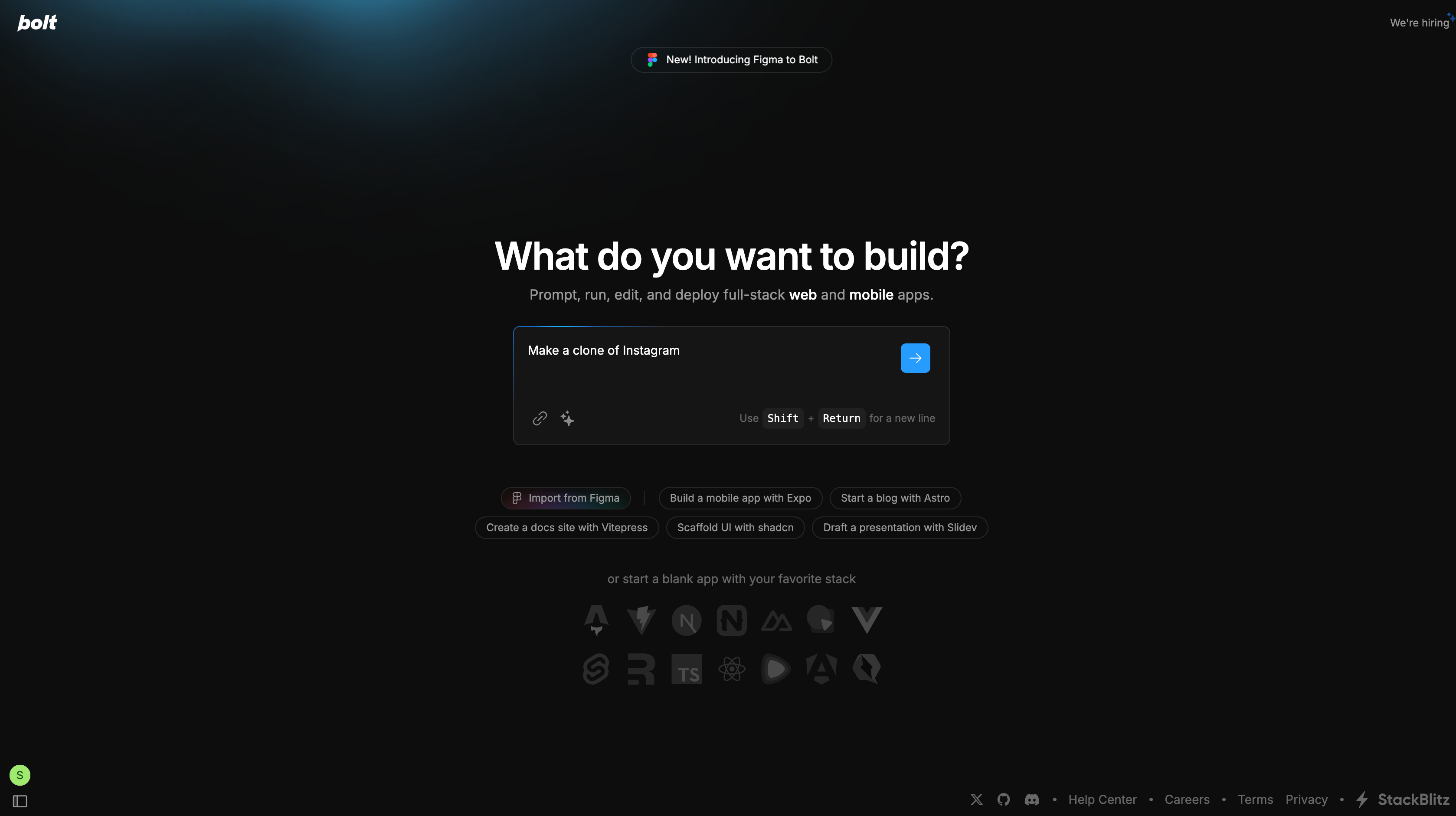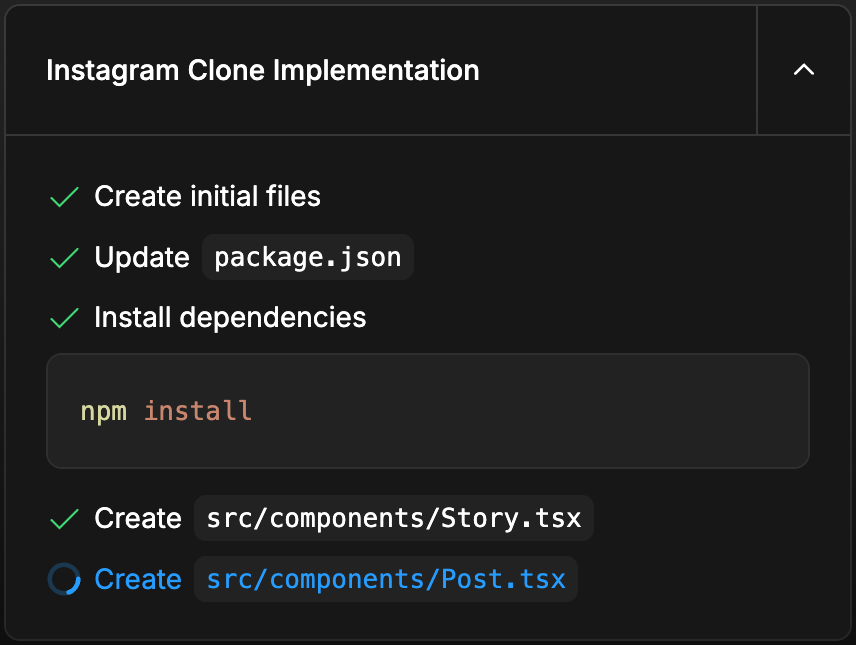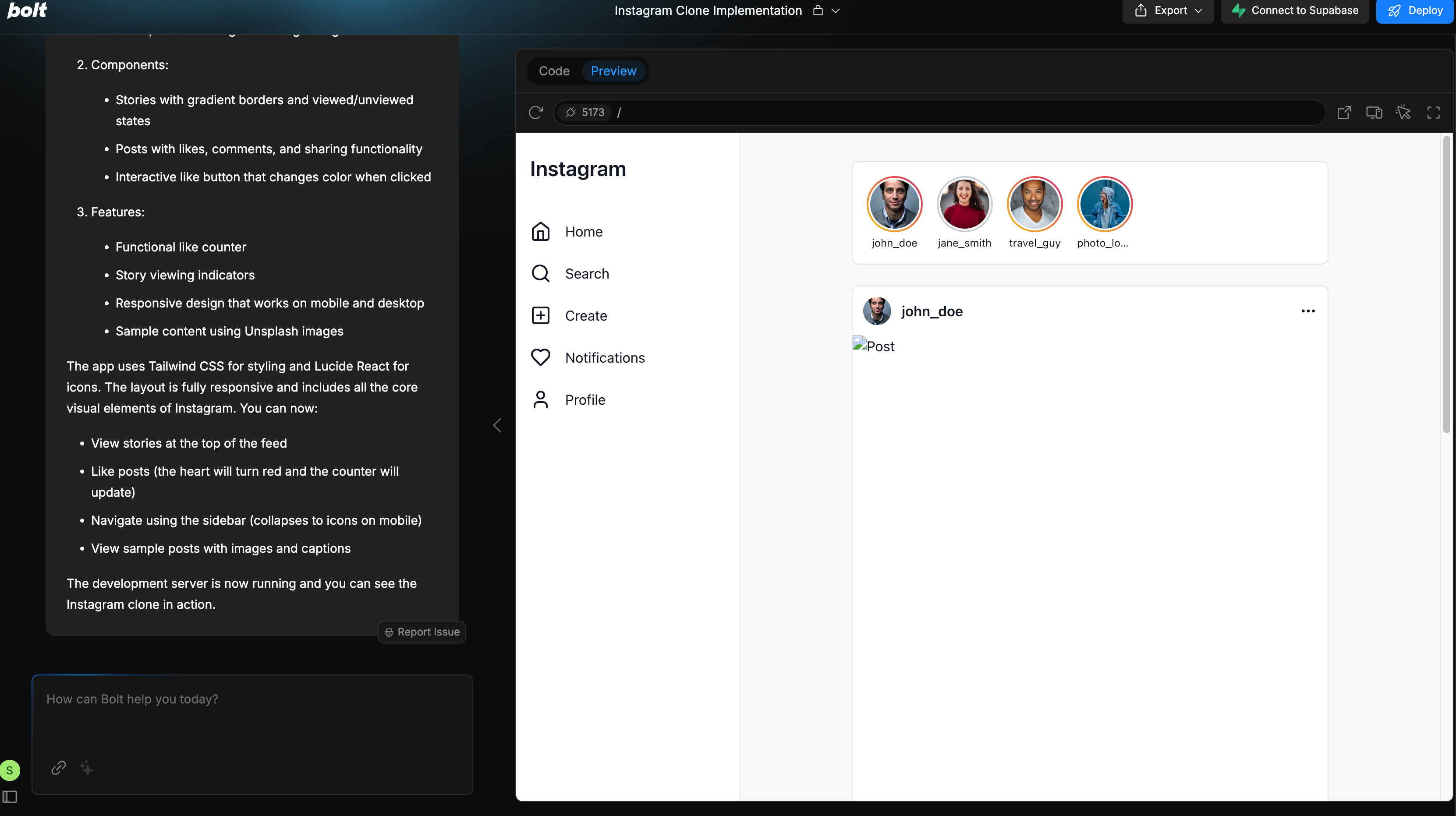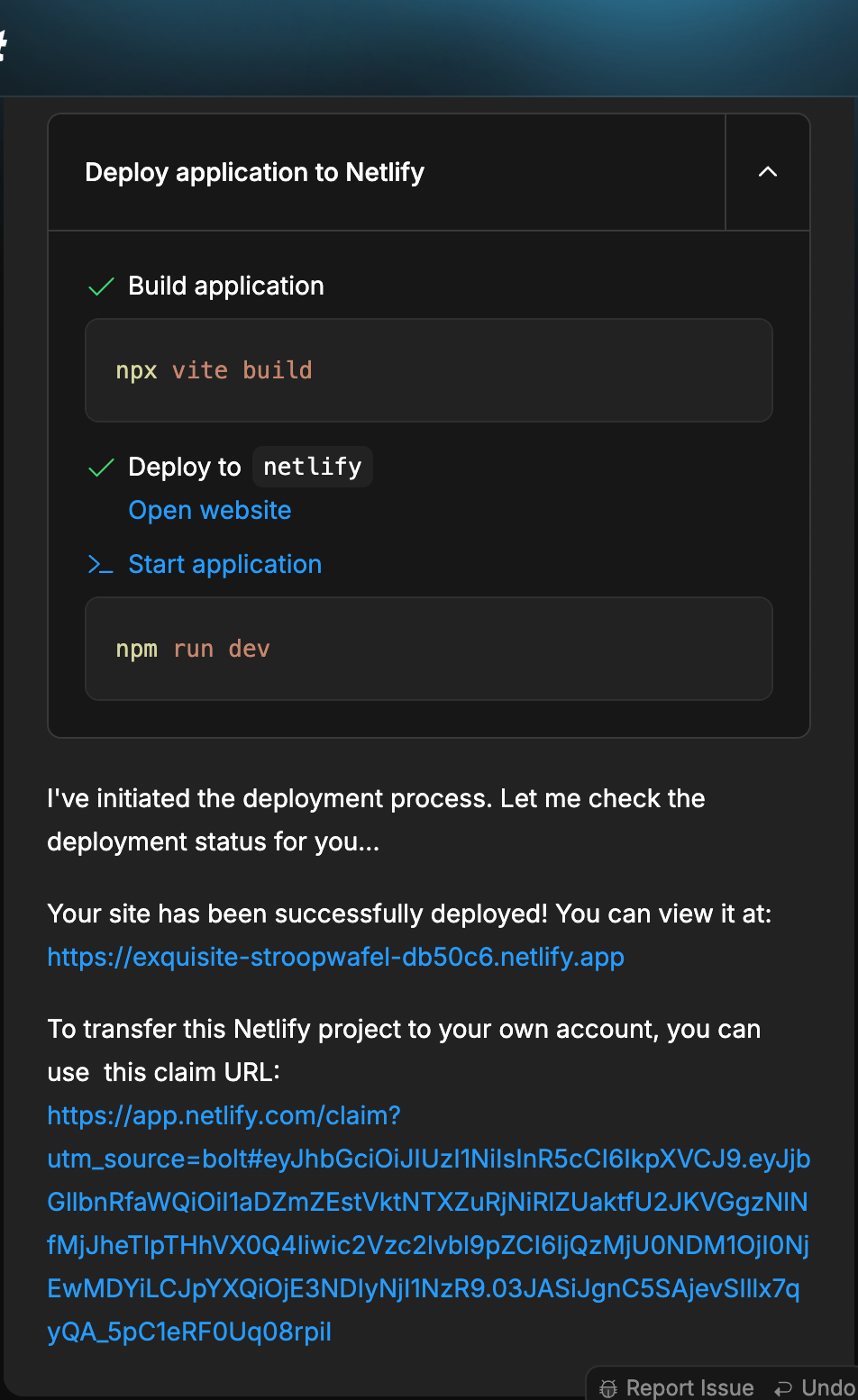Bolt Product
Case Study
Executive Summary
StackBlitz's Bolt (also known as Bolt.new) represents a revolutionary approach to web development, combining WebContainers technology with Claude 3.5 Sonnet AI to create a text-to-app platform. This case study examines Bolt's unique technology, rapid growth trajectory, competitive positioning, and future potential in the AI-assisted development space.
About The Company
StackBlitz, the company behind Bolt (also known as Bolt.new), was founded in 2017 by Eric Simons and Albert Pai with the vision of making web app development accessible to everyone. The two founders had been coding together since they were 13 years old and grew up near each other in Chicago before moving to Silicon Valley in 2012.
Company History
Early Days and Inspiration
Eric and Albert were inspired by meeting Figma founders Dylan Field and Evan Wallace in the early days when Figma was developing browser-based technology. This encounter helped shape their vision for what would become StackBlitz.
Pre-StackBlitz Ventures
Before founding StackBlitz, the pair worked on other startups:
- They built ClassConnect, during which a 19-year-old Eric famously lived in AOL's headquarters for $1/day to keep his startup dream alive
- They launched Thinkster, an online programming platform, in 2013
- They worked with technologies like Django, Angular, React, and TypeScript before exiting their startup in 2018
StackBlitz Development
The core technology behind StackBlitz is WebContainers, a revolutionary browser-based operating system that took seven years to develop. This technology allows developers to run a full operating system directly in the browser, enabling instant coding without complex setups or cloud infrastructure.
Near-Death Experience
Despite years of development, StackBlitz faced significant challenges:
- The company nearly shut down in the summer of 2024, just months before Bolt's launch
- They attempted to build an early version of Bolt in January 2024, but the AI models available weren't capable enough for effective code generation
- The company was on the brink of running out of cash completely
Bolt's Breakthrough
Launch and Growth
When more advanced AI models like GPT-4o and newer versions of Claude became available, StackBlitz launched Bolt in October 2024. The growth was unprecedented:
- $5 million ARR within weeks of launch
- $20 million ARR within two months
- By March 2025, they reached nearly $40 million ARR
- Attracted 3 million registered users with approximately 1 million monthly active users
Technology and Innovation
Bolt leverages StackBlitz's WebContainer technology combined with Anthropic's Claude 3.5 Sonnet model to create a text-to-app platform. This integration allows users to:
- Build full-stack applications simply by typing prompts into a text box
- Generate code that's production-ready
- Develop without needing to set up local environments or servers
Current Status
As of March 2025, StackBlitz has:
- A team of only 15-20 people managing their explosive growth
- Forecasts aiming for $100 million ARR by the end of 2025
- Backing from investors including Greylock and GV
The company's success is attributed to their long-term vision, the strength of their core team (many of whom have been with the company for over five years), and their revolutionary WebContainer technology that enables a dramatically faster, more reliable AI coding experience than competitors.
Basic Workflow
Start with a prompt
Tell Bolt what you want to build. While you can start with as few as 5 words, providing detailed specifications yields better results.

Generate your app
Bolt uses Claude 3.5 Sonnet to transform your prompt into working code.

Customize your code
After generation, you can manually edit your code in Bolt's browser-based IDE.

Install packages
Unlike many AI coding tools, Bolt lets you install NPM packages and configure backends without leaving the platform.

Deploy
When you're ready, deploy your app with one click using the integrated Netlify support.

Bolt supports popular frameworks like Next.js, Astro, Svelte, and Vue, and allows integration with databases like Supabase and Firebase. This makes it perfect for quickly building MVPs, experimenting with new technologies, or creating demos without complex local setup.
Whether you're a developer looking to speed up your workflow or someone with limited coding knowledge wanting to bring your ideas to life, Bolt offers a streamlined path from concept to deployed application.
Competitor Analysis: Bolt.dev vs Alternatives
| Platform | Pricing | Key Tech | Features | Best For |
|---|---|---|---|---|
| Bolt.dev | Free tier with premium options | WebContainers | AI-powered code gen, browser-based | Rapid prototyping |
| Hostinger | $19.99/mo | Cloud-based | Integrated hosting, live preview | Beginners |
| Lovable | $20/mo | Cloud-based | Mobile conversion, Figma integration | Designers |
| v0 (Vercel) | $20/mo | Cloud-based | Built-in IDE, vercel integration | Frontend devs |
| Replit | $15/mo | Cloud-based | Version control, multi-language | Teams |
| Softgen | $25/mo | Cloud-based | GitHub integration, autonomous mode | Pro devs |
Web-OS vs Cloud-OS for No-Code Tools
Why Web-OS Is More Efficient
Web-OS platforms (like Bolt.dev's WebContainers) run directly in the browser, providing several crucial benefits:
- Lower Latency: Processing happens directly in the browser without server round-trips
- Offline Capability: Many functions work without constant internet connection
- Reduced Server Costs: Less reliance on remote cloud infrastructure
- Device Independence: Runs on any device with a compatible browser
Key Benefits of Bolt's Web-OS Approach
- Speed: Eliminates server dependency, faster than cloud-based alternatives
- Reliability: Less dependent on network conditions and server availability
- Scalability: Distributed processing model handles traffic spikes better
- Cost-effectiveness: Lower server costs translate to competitive pricing
For businesses seeking rapid application development with minimal infrastructure concerns, Bolt.dev's web-OS technology provides significant advantages over traditional cloud-based no-code platforms.
Performance Metrics
Speed Metrics
- Code generation: 0.5-2 seconds
- Environment startup: 1-3 seconds
- Hot reload: 500ms
- Database queries: 50-200ms
- Full app deployment: Under 5 minutes from concept to live deployment
Resource Usage
- Browser memory usage: 200-500MB
- CPU utilization: 10-30%
- Network bandwidth: 50-200KB/s
Time & Cost Savings
Bolt.new significantly reduces development time compared to traditional methods:
- Project setup: Minutes vs. hours for traditional setup
- Deployment process: Single click vs. complex cloud configurations
- Full-stack app creation: 5 minutes vs. typical hours-long process
Comparative Performance
| Feature | Bolt.new | Lovable.dev | V0/Replit/Others |
|---|---|---|---|
| Code generation | 0.5-2 seconds | 1-3 seconds | Limited data |
| Project initialization | 1-3 seconds | 2-5 seconds | Varies (typically 5-10s) |
| Memory usage | 200-500MB | 150-400MB | Varies by platform |
| AI capabilities | Complete environment control | Limited to code suggestions | Varies by platform |
| Deployment | One-click | Multi-step process | Varies by platform |
User Satisfaction
While specific NPS scores aren't publicly available, user sentiment can be gauged from developer feedback:
- Developers report high satisfaction with Bolt.new's speed and simplicity
- The platform's AI integration is described as a "game-changer" by users
- 82% of developers are leveraging AI for app development, with Bolt.new tapping into this trend
Market Analysis
Industry Trends Bolt is Capitalizing On
- AI Integration in Development: By 2025, 89% of small businesses have adopted AI to automate tasks and boost productivity. Bolt leverages advanced AI (Claude 3.5) to automate app creation.
- Low-Code/No-Code Revolution: Low-code/no-code platforms are dramatically accelerating software development, cutting coding time by up to 90% and development costs by nearly half.
- Multimodal AI Capabilities: Modern AI models now integrate multimodal inputs (text, audio, images) and advanced reasoning capabilities.
- Cloud-based GPU Integration: Increasing computational power through cloud GPUs allows handling complex AI tasks without local hardware constraints.
Target Market Segments
Startups & SMEs
- Needs: Cost-effective, rapid development tools; minimal technical expertise required.
- Bolt's Offering: One-click deployment, significant cost savings (up to 99%), minimal setup time.
Enterprise Users
- Needs: Secure, scalable solutions; integration capabilities; reduced dependency on specialized developers.
- Bolt's Offering: Advanced security measures planned, scalability through cloud integrations, reduced reliance on specialized talent via AI automation.
Citizen Developers & Non-technical Users
- Needs: Easy-to-use interfaces, visual drag-and-drop features, minimal coding knowledge required.
- Bolt's Offering: Intuitive browser-based UI, powerful AI-driven app generation from simple descriptions.
Market Size & Growth Projections
| Market Segment | Market Size & Growth Projections |
|---|---|
| AI Software Overall | $257.37 billion by 2025; CAGR of 21.43% through 2034 |
| Low-Code/No-Code Platforms | $187 billion by 2030; CAGR ~31% |
| Generative AI Coding Assistants | $97.9 billion by 2030; CAGR of 24.8% |
| No-Code Development Platforms Specifically | $35.86 billion in 2025; CAGR of ~27.6% |
Personal Analysis & Reflection
Strengths & Weaknesses Assessment
Strengths
Bolt's implementation of WebContainers technology creates a development experience that stands apart from traditional no-code solutions. Through hands-on comparison with competitors, I've observed that Bolt consistently delivers superior development speed and runtime performance. The browser-native approach eliminates the latency issues that plague cloud-based alternatives, resulting in a remarkably fluid development experience even for complex applications.
The integration with Claude 3.5 Sonnet produces code that is not only functional but production-ready – something many AI coding tools promise but rarely deliver. This allows developers to focus on refining rather than rebuilding generated code, significantly accelerating the development lifecycle.
Weaknesses
Where Bolt currently falls short is in UI sophistication compared to tools like V0, which consistently produces more polished visual designs out-of-the-box. Additionally, Bolt's ecosystem of integrations remains more limited than Lovable's extensive partnership network, potentially requiring developers to implement custom solutions for certain third-party services.
As a direct competitor to Cursor and increasingly to Claude's Multimodal Code Processor (MCP), Bolt faces significant challenges in maintaining its technological edge, particularly as large language models continue their rapid advancement. The relatively small team size (15-20 people) managing such explosive growth also raises questions about long-term scalability and support infrastructure.
Opportunities for Improvement
The current generation of no-code tools, including Bolt, still heavily depends on precise prompt engineering to achieve optimal results. This creates an unnecessary barrier for non-technical users and reduces the effectiveness of these platforms for their intended purpose – democratizing software development.
I envision a more intelligent prompt optimization system where the initial user interaction doesn't immediately trigger application generation. Instead, the system should engage in a structured dialogue to clarify requirements, resolve ambiguities, and explore edge cases before producing code. This approach would mirror the consultative process that experienced developers naturally follow when gathering requirements.
Just as Python made programming more accessible to those intimidated by C++ or Java's complexity, these tools need a conversational layer that bridges the gap between vague human instructions and precise computer requirements. This would transform no-code platforms from mere convenience tools for developers into true enablers for the non-technical business user.
Product Significance
What makes Bolt particularly revolutionary is its WebOS foundation. While the concept seems simple – running development environments in the browser – the implications are profound. In our increasingly online world, this approach eliminates the traditional boundaries between ideation and implementation.
The significance extends beyond technical elegance. By removing the complex setup requirements and infrastructure dependencies that traditionally gate software development, Bolt enables rapid prototyping and iteration cycles that were previously impossible without specialized knowledge.
For product managers and designers, this means the ability to transform concepts into functional demonstrations without engineering dependencies. For small businesses and solo entrepreneurs with limited resources, it represents access to capabilities that would otherwise be prohibitively expensive or technically out of reach.
In the broader technology landscape, Bolt exemplifies how AI and browser-native computing are converging to fundamentally reshape software development. Just as cloud computing democratized infrastructure access, tools like Bolt are democratizing the development process itself – potentially unlocking innovation from previously untapped sources and accelerating the overall pace of technological advancement.
Thank You
Thank you for exploring this comprehensive case study on Bolt and StackBlitz's innovative approach to web development. This analysis represents my passion for understanding how emerging technologies are reshaping the development landscape.